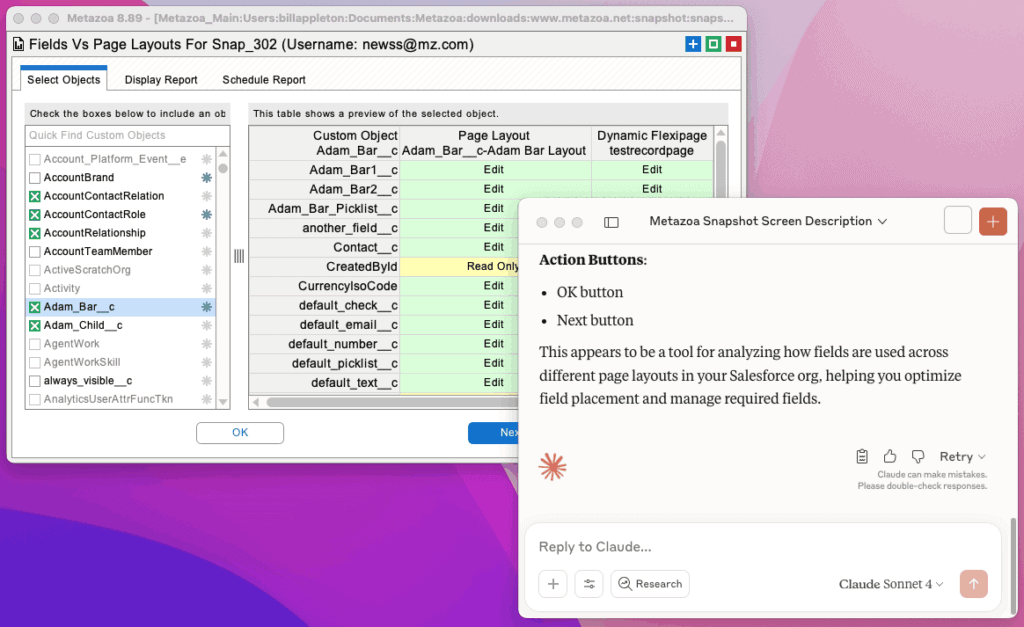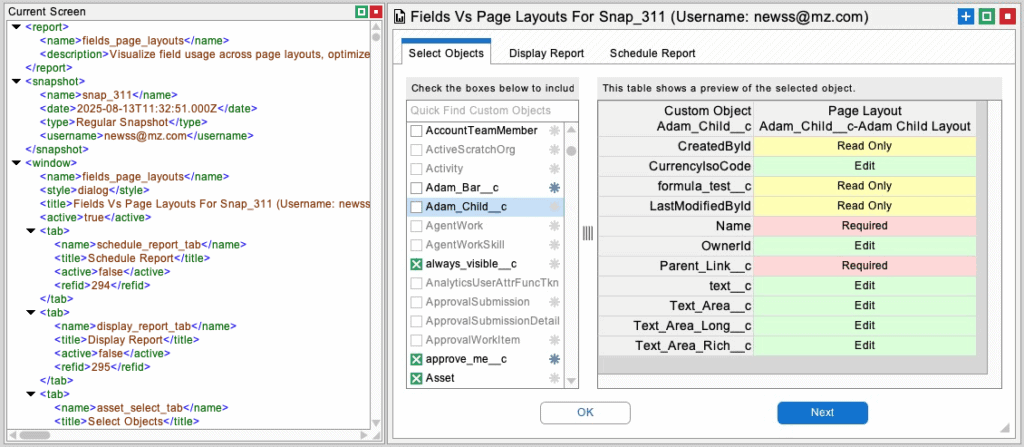Introduction: MCP Servers Bring Metadata Intelligence to Life
Salesforce Administrators live inside one of the most complex environments in enterprise software. Thousands of metadata assets. Entangled dependencies. Technical debt that never sleeps. For years the pattern was the same: run a report, export the data, analyze, plan, and then make changes manually across a maze of tools.
With the integration of the Snapshot MCP Server and local AI client applications like Claude Desktop, a different way of working is here: a local, secure, AI-enabled workstation on your desktop. Not a chatbot in a browser. Not a cloud service with org access. A partner that understands what you see, can act when you ask, and can fetch the underlying metadata to explain, fix, and plan. A personal collaboration between Assistant and Administrator. This is the workstation of the future for Salesforce org management.

Three Levels of AI in Snapshot
We designed the Snapshot MCP experience around three escalating capabilities. Each level compounds the value of the last:
- AI can see your screen (via structured context, not pixels)
- AI can click and act (with clear guardrails and confirmations)
- AI can fetch and elaborate (diving beneath reports to source assets)
Level One: AI Can See Your Screen
The first breakthrough is simple and transformative: Snapshot doesn’t show the AI a flat picture of the screen, it provides a structured map of what’s really happening. Instead of staring at pixels, the Assistant receives the logical layout of reports, tabs, buttons, and charts — each one labeled with meaning.
That structure changes everything. It means the Intelligent Assistant can follow the same logical hierarchy that the Salesforce Administrator uses, instantly understanding that one item is an Apex class, another is a Flow, and where each one belongs on the report you’re working on. The Assistant knows exactly which asset you’re looking at, how it relates to real metadata, and what actions are possible.

Designing UI for AI
The rise of AI copilots introduces a new design challenge: building interfaces that humans and machines can both navigate and understand. For the AI, the UI isn’t about pixels — it’s about structure, meaning, and traceability. The result is an interface that feels natural to people while also giving AI the clarity it needs to act safely and intelligently.
- Logical over visual: group objects by hierarchy, not how they look on screen.
- Stable identifiers: use durable IDs for assets instead of positional selectors.
- Semantic labels: use real metadata types and asset names so intent is unambiguous.
- Traceable relationships: use explicit parent–child references to the source assets.
- Action taxonomy: mark possible actions as read_only_permit or write_high_risk.
- Explainability hooks: provide “why” information AI can surface in reasoning.
Level Two: AI Takes Action
Seeing is useful; acting is transformative. Through MCP, the Assistant can perform bounded UI actions: open tabs, drill into report rows, launch previews, save output to a project folder, and prepare deployments. The first time we gave Claude “click” privileges, it explored like a curious intern — navigating broadly to learn the landscape. That told us two things: the capability is powerful, and guardrails are essential.
Guardrails Keep the Human in Charge
- Follow the Administrator’s lead: no autonomous navigation unless asked.
- Action boundaries: distinguish read-only activities from write-enabled actions.
- Confirmations: destructive or high-impact operations require explicit consent.
- Role framing: define the Assistant as a fast, careful, collaborative partner.
Designing for Safe Action
Designing for safe action means building the interface so the AI knows exactly what it’s doing and the human always stays in charge. Actions are explicit and descriptive, previews appear by default before anything is committed, and the Assistant only receives the minimum context needed to complete the task. This transforms the AI from a runaway agent into a trusted co-pilot — fast enough to handle routine steps in seconds, but disciplined enough to leave every meaningful decision in the Administrator’s hands.
Level Three: AI Can Fetch and Elaborate
The moment that changes everything is when you ask a question about a report and the Assistant fetches the underlying assets behind the results. This brings a personal and collaborative touch to context engineering. The transition from dashboard commentary to hands-on investigation adds an entirely new dimension to any Snapshot report.
Ask your Assistant, “Can you show me the code with that hard-coded ID?” and the Assistant pulls the Apex class, highlights the line, proposes a refactor using Custom Metadata, and estimates effort by asset type. No exporting. No hunting. Just answers backed by the metadata and artificial intelligence in perfect context.
From Insight to Action
Snapshot delivers the best Metadata Intelligence. Now, connected to an Intelligent Assistant in perfect context, that intelligence becomes instantly actionable. The Assistant can pull the exact code or configuration behind a finding, explain the issue, and propose a fix — all within the same workflow. Every recommendation is tied directly to the underlying metadata, giving the Salesforce Administrator clear, trustworthy answers they can act on immediately.
The Zero Trust Advantage
Many MCP servers operate in the cloud, and proxy org credentials and metadata through external systems. That model expands the attack surface and creates trust dependencies that regulated industries cannot accept. Snapshot takes a different path. Both the Snapshot MCP Server and Claude Desktop run entirely on your local workstation, following a Zero Trust architecture that keeps your org secure and fully under your control.
- No Public Endpoint: Nothing for attackers to scan, probe, and exploit.
- No Exposure: No intermediate cloud or database with your data and metadata.
- Zero Trust by Design: Your org, your hardware, your team, your network.
- Maximum Performance: Instant access to Metadata Intelligence, no cloud latency.
The AI-Enabled Workstation (Manifesto)
Shared context. Shared control. Shared insight. With Snapshot’s local MCP server and an Intelligent Assistant like Claude Desktop, Salesforce Administrators can move from reactive maintenance to proactive strategy. The Assistant doesn’t replace the admin; it empowers them — seeing what they see, acting when asked, and digging into the metadata to turn findings into fixes and roadmaps.
Enterprise teams in healthcare, finance, and government can adopt this model confidently: everything runs locally, actions are auditable, and the org’s intelligence never leaves the workstation. That combination of security, performance, and context is what makes this workstation real. The future of Salesforce org management isn’t more dashboards or spreadsheets. It’s a secure desktop environment where human expertise and AI insight work side by side — fast, safe, and deeply informed.
 Congratulations!
Congratulations! 